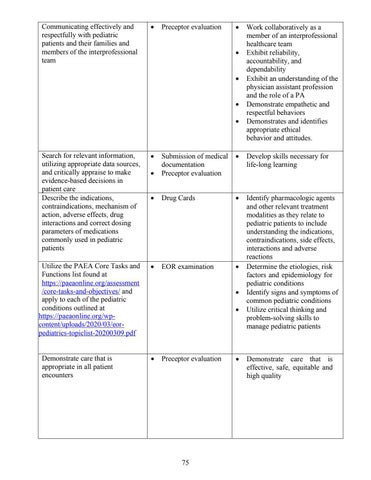Communicating effectively and respectfully with pediatric patients and their families and members of the interprofessional team
•
Preceptor evaluation
• • • • •
Search for relevant information, utilizing appropriate data sources, and critically appraise to make evidence-based decisions in patient care Describe the indications, contraindications, mechanism of action, adverse effects, drug interactions and correct dosing parameters of medications commonly used in pediatric patients
•
Utilize the PAEA Core Tasks and Functions list found at https://paeaonline.org/assessment /core-tasks-and-objectives/ and apply to each of the pediatric conditions outlined at https://paeaonline.org/wpcontent/uploads/2020/03/eorpediatrics-topiclist-20200309.pdf
Demonstrate care that is appropriate in all patient encounters
Work collaboratively as a member of an interprofessional healthcare team Exhibit reliability, accountability, and dependability Exhibit an understanding of the physician assistant profession and the role of a PA Demonstrate empathetic and respectful behaviors Demonstrates and identifies appropriate ethical behavior and attitudes.
•
•
Submission of medical documentation Preceptor evaluation
Develop skills necessary for life-long learning
•
Drug Cards
•
•
EOR examination
•
Identify pharmacologic agents and other relevant treatment modalities as they relate to pediatric patients to include understanding the indications, contraindications, side effects, interactions and adverse reactions Determine the etiologies, risk factors and epidemiology for pediatric conditions Identify signs and symptoms of common pediatric conditions Utilize critical thinking and problem-solving skills to manage pediatric patients
• •
•
Preceptor evaluation
75
•
Demonstrate care that is effective, safe, equitable and high quality


